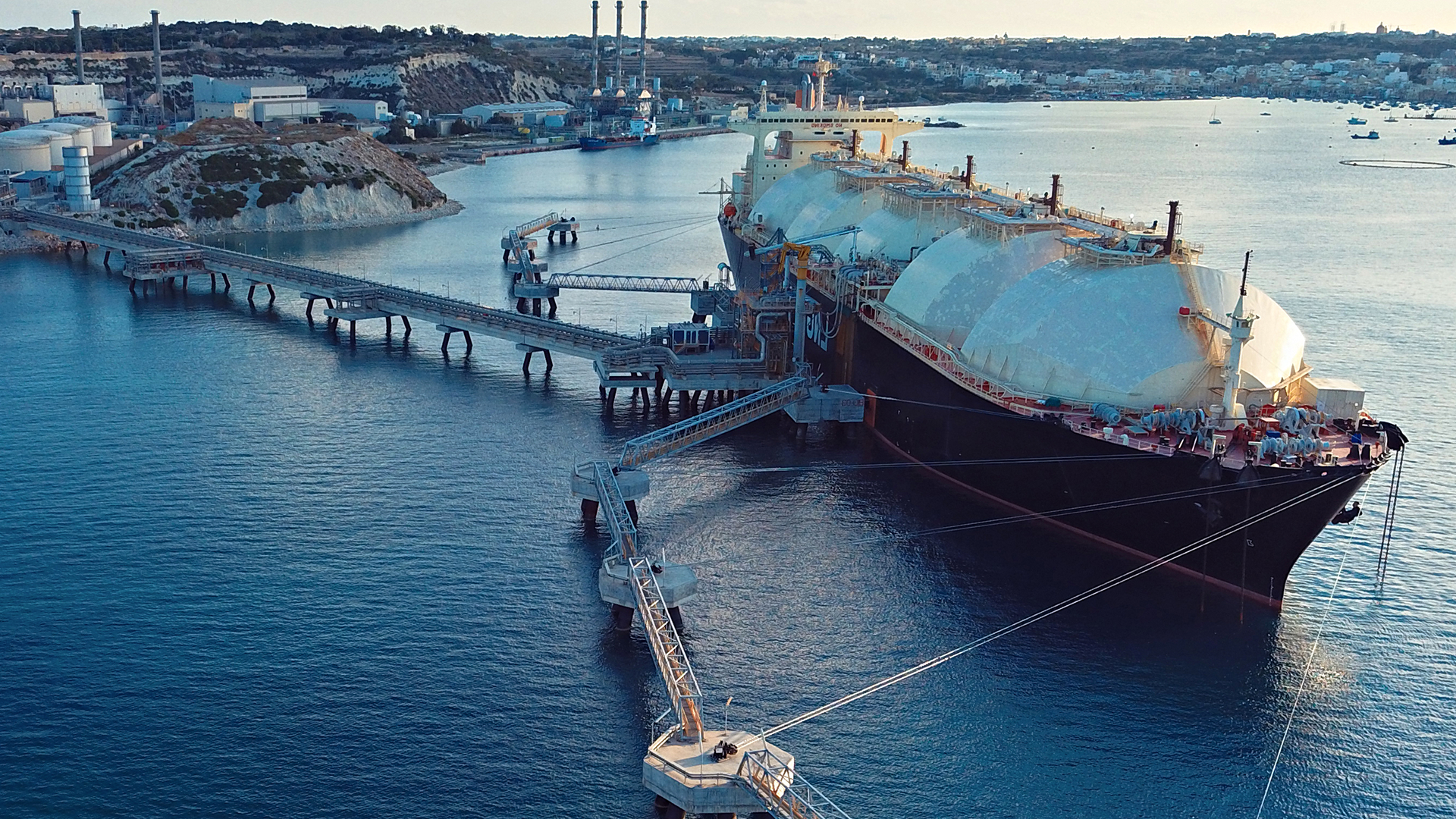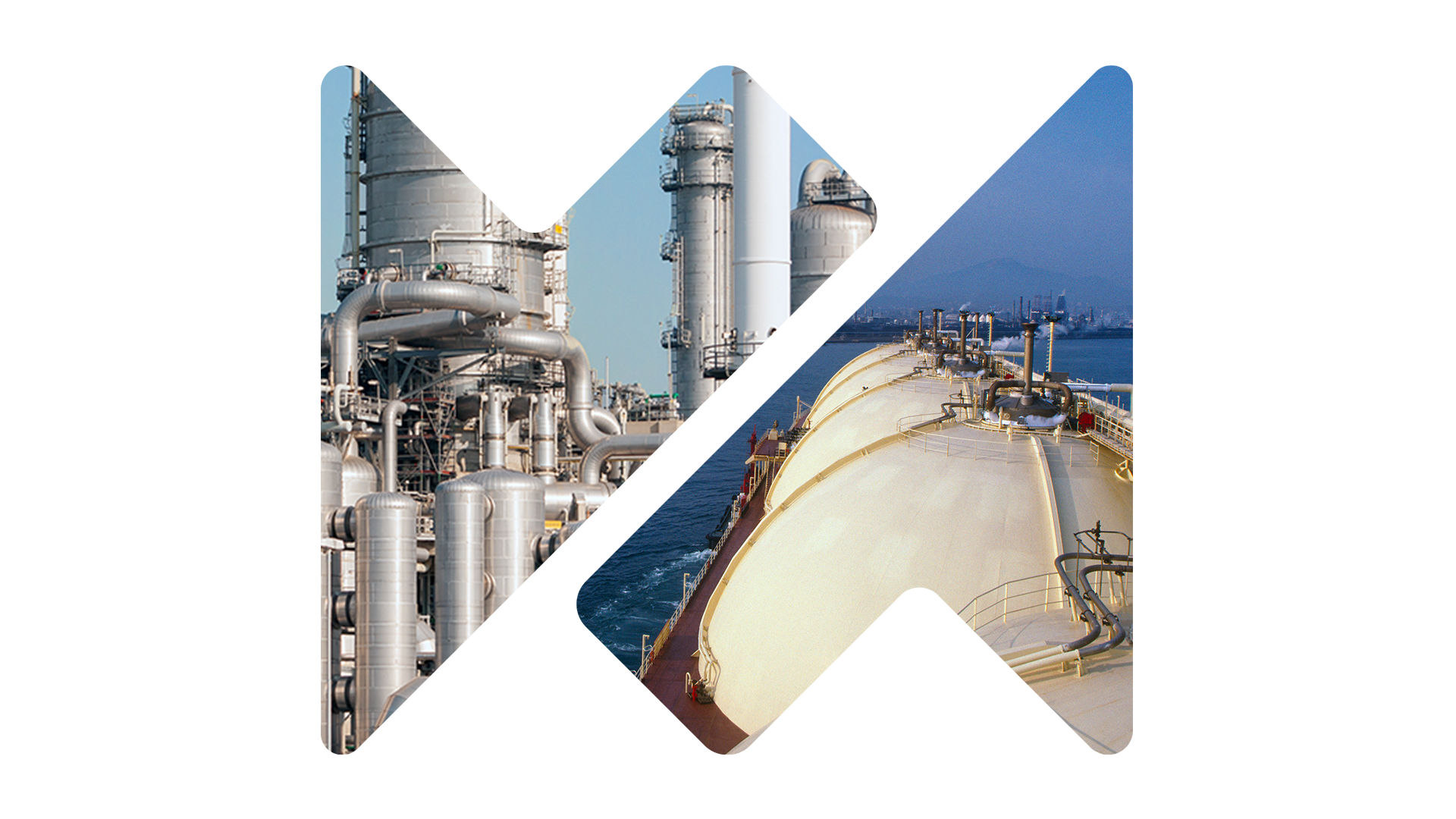Call of duties
How emission taxes on imports could transform the global LNG market
March 2024
Authors
The environmental credentials of liquified natural gas (LNG) are under increasing scrutiny. Despite emitting about half the CO2 of coal when combusted, the LNG value chain remains highly carbon intensive and plagued by methane losses.
In response, LNG players are actively working to reduce the greenhouse gas (GHG) footprint of their projects. This all comes at a cost, however, and buyers’ reluctance to pay a premium for lower-emission LNG has so far curbed sellers’ appetite to commit to major investment to reduce carbon intensity.
This could be about to change. With the European Union (EU) extending its Emission Trading Scheme (ETS) to shipping, LNG cargoes into Europe will be subject to a carbon tax from 2024. The EU has further agreed to start monitoring methane emissions of countries and companies and to define acceptable limits for fossil-fuel imports across the value chain. For now, the first draft only refers to new LNG import contracts, but a methane tax on all LNG imports exceeding defined limits cannot be ruled out. The bloc could go further and include LNG in its Carbon Border Adjustment Mechanism (CBAM), setting an import duty at prevailing ETS carbon prices.
Such a move will push up European gas prices, bifurcating the global LNG market and creating a European premium, as prices in markets without taxes will be lower. If taxes were limited to the EU, or even extended to Japan and South Korea, trade flows would likely be optimised to mitigate the impact.
This does not mean that the EU’s moves can be ignored, however. US projects, in particular, will be motivated to reduce their methane emissions as they target higher European prices. But emissions taxes limited to Europe and the mature LNG markets of Northeast Asia alone will be insufficient to motivate LNG players to act decisively to reduce all GHG emissions. Only if widened to the emerging markets of Asia would a substantial tax provide the economic incentive for the industry to invest in more costly abatement options.
In this month’s Horizons, we assess the carbon intensity of LNG projects around the world and the effects of LNG emission tax scenarios. With the lure of higher margins in premium markets, LNG suppliers must be ready to act.
Source of emissions across the LNG value chain
LNG projects are among the most emission-intensive energy assets. Natural gas must first be extracted, then processed, transported by pipeline, liquefied and shipped, often thousands of kilometres to where it is consumed, with emissions occurring across the value chain.
But not all LNG projects are created equal. GHG footprints vary depending on the CO2 content of the reservoir gas, levels of methane leakages from production, infrastructure and processing, and how liquefaction and regasification are powered. Construction vintage also impacts emissions, with recently built facilities and ships likely to be more efficient and less carbon intensive. Distance to market is another clear factor in shipping emissions.
Figure 1: GHG emissions intensity (kg/CO2 equivalent) by region (wellhead to LNG loading point)
Source: Wood Mackenzie LNG Carbon Emissions Tool
We have used Wood Mackenzie’s new LNG Carbon Emissions Tool to assess carbon and methane emissions by project and across the value chain, from the wellhead to regasification. Our analysis shows that upstream production, and the amount of methane and reservoir CO2 vented, generates the lion’s share of emissions. It also reveals a wide variance in levels of methane emissions. Measured in kgCO2 equivalent, methane only accounts for 5% to 15% of overall carbon intensity in LNG projects outside the US. But for LNG projects in the US, methane can account for as much as 25% to 40%, due to higher levels of methane losses largely because of the extensive use of pneumatic devices and compressors associated with shale gas production.
The overall carbon intensity of LNG projects also varies significantly by region. Russia and the Middle East are home to some of the least carbon-intensive LNG projects. Construction vintage weighs on emissions in Africa and Asia Pacific. However, with a range of 800 to 1400 kg CO2e/t LNG, the US has some of the world’s highest-emitting projects, with upstream reservoir type and pipeline distance to LNG plants adding to their high methane intensity.
The impact of these emissions on the future delivered cost of LNG projects will depend on how much methane and/or CO2 is taxed. The EU ETS carbon price, used as the reference price in those sectors that already fall within the CBAM, makes it a plausible reference for how the bloc might consider taxing both methane and carbon emissions. The EU ETS price is extremely volatile, though. It traded above US$100/t for much of the last year before dropping to US$50/t recently, partly due to warmer temperatures moderating energy demand. And a future EU ETS price of US$200/t cannot be ruled out as Europe sets increasingly ambitious carbon-emission reduction targets.
The following chart illustrates changes to the LNG cost curve to Europe based on our understanding of current project emissions and assuming a carbon-equivalent tax of US$50/t, US$100/t and US$200/t applied to methane only and to overall GHG emissions. Some measures to reduce GHG emissions are likely to be applied over time, helping reduce emissions intensity from current levels. However, these varying scenarios help frame a clear picture of how taxes on emissions would affect the economics of LNG projects.
Figure 2: LNG delivered cost to Europe based on alternative methane and CO2 emission import taxes
Note: Methane taxes of US$1,400, US$2,800 and US$5,600 per tonne of CH4 have been used, equating to taxes of US$50, US$100 and US$200 per tonne of CO2e, respectively, assuming a global warming potential (100-year GWP) of 28, in line with the IPCC Fifth Assessment Report.
Source: Wood Mackenzie LNG Service and Wood Mackenzie LNG Emissions Tool
The big reshuffle of LNG flows
We have used Wood Mackenzie’s newly developed Lens Gas and LNG Market Model to explore the impact of certain regions imposing taxes on LNG imports based on their GHG emissions. Our model considers gas and LNG demand globally and simulates how gas/LNG players could optimise flows based on relative costs.
The implications for global gas and LNG dynamics are profound. Gas prices in markets that impose a tax on GHG emissions will inevitably increase, as marginal suppliers need to recover the cost of the additional tax. LNG players with destination flexibility will need to evaluate what strategy maximises their profitability, either focusing on markets without import taxes on emissions or investing to decarbonise and supplying premium markets that impose taxes. In addition to prevailing prices and shipping costs, the value of their carbon intensity will come front and centre as LNG players optimise their portfolios. LNG trade flows change dramatically as a result, potentially revolutionising the price-setting mechanism.
For our analysis, we have considered a carbon tax of US$100/t of CO2e and simulated three scenarios: a methane tax on EU imports, an overall GHG emissions tax on EU imports only, and a tax also applied in Japan and South Korea.
The results frame a picture of how gas/LNG trade flows and prices would change if GHG emissions from LNG projects were to remain at current levels.
1. The EU imposes an import tax on methane only
The implications for prices are modest. European prices increase by just US$0.6/mmbtu, or 6.5%, as, despite the relatively high tax, methane makes up a small share of overall GHG emissions. However, with the EU still needing some US LNG, the marginal cargo from North America will continue to set the European price. With the methane intensity of US LNG much higher than elsewhere, this should provide the necessary push for some LNG players in the Atlantic Basin to reduce their methane emissions as they target higher European prices.
2. The EU imposes a wider import tax on all GHG emissions
A wider GHG emission tax will have a material impact, increasing European prices by US$1.7/mmbtu, or 18%. Europe will emerge as the clear premium global LNG market, as US LNG players will require the same netback value they can achieve in Asia. Over time, though, a decline in European LNG demand will mean US LNG being displaced by lower-carbon LNG alternatives, setting the scene for the European price premium to decline. Inevitably, this limits incentives for US LNG and other players to invest to decarbonise.
Figure 3:
Source: Lens Gas & LNG Market Model
3. Japan and South Korea also impose an import tax on emissions
Prices in Japan and South Korea increase by some 18%, re-establishing the traditional price premium over Europe. Lower-carbon LNG displace US LNG, although some will still be required to meet demand, resulting in Northeast Asian prices reflecting the full burden of US LNG tax costs in those markets. However, prices in the rest of Asia will see no premium, given the absence of an import tax on emissions.
What are the options for reducing emissions?
Opportunities to reduce LNG emissions depend on the characteristics of individual projects and relevant carbon prices and taxes. Despite numerous corporate announcements on potential emissions abatement schemes at a wide range of existing and planned LNG facilities, few options deliver sufficient cost-effective emissions reductions to offset the added cost of carbon and methane taxes.
Figure 4: Range of carbon equivalent emission intensity across the LNG value chain
Source: Wood Mackenzie LNG Emissions Tool
The optimal abatement options broadly fall into four categories:
Methane abatement: US gas producers are already reducing methane emissions from their operations, largely focusing on pneumatic devices and compressors. In line with certification frameworks (such as MiQ), supply from some of the country's most prolific basins has shown dramatic reductions in levels of associated methane loss and, thus, carbon intensity. In some instances, this has resulted in reductions of up to 40% of upstream emissions (wellhead to transmission) and is one of the most cost-effective options for tackling emissions. With the Inflation Reduction Act’s methane charge applying a tax escalating to US$1,500/tCH4 (equivalent to a CO2e tax of US$53/t) by 2026 for emissions above certain thresholds from the wellhead to the LNG plant, considerable further emission reductions are expected, even without considering an import tax in Europe.
Carbon capture and storage (CCS) of reservoir CO2: For LNG projects with high reservoir CO2 content, venting can be the key driver of emissions intensity and result in some of the highest-emission LNG projects in the world (for example, more than 55% of emissions from the wellhead to LNG loading for Tangguh LNG stems from CO2 venting). However, with costs of US$50 to US$120 per tonne, the viability of CCS depends on the availability of proximate injection sites along with some level of regulatory support (such as the 45Q tax credit for carbon sequestration in the US).
The impact of CCS on projects with high CO2, such as Gorgon and Snohvit, has been considerable, reducing total pre-shipping emissions by around 30%. Future projects that are planning or have proposed CCS – such as Qatar’s North Field East, Tangguh, MLNG 9 and Barossa – could see emissions reductions by around one-third on average.
Figure 5: Impact of CCS of reservoir CO2 on emission intensities (wellhead to LNG loading point)
Note: For projects that are planned or proposed (such as NFE, Tangguh, MLNG 9 and Darwin), we assume 80% of the separated reservoir CO2 is sequestered. Source: Wood Mackenzie
Electrification: Emissions from the liquefaction process can be reduced by using electric drive turbines powered by low-carbon power supplies from a proximate power grid, providing up to an 80% reduction in liquefaction emissions. In the US, existing grid-connected electric drive projects include Freeport and Elba Island LNG, while new-build projects include Corpus Christi Stage 3 and Cameron Phase 2 LNG projects.
Several existing and proposed electric-drive LNG projects are not grid-connected (Ichthys, Papua LNG). Powered by dedicated gas-fired combined-cycle gas turbines, these projects are highly efficient. But they lack the supply of low-carbon grid power that can make electrifying liquefaction attractive from an emissions reduction standpoint.
Retrofitting electric drives at existing projects is also under consideration. However, with significant costs already sunk in existing gas-fired turbines, this is a less economic proposition.
Other options: Several other options that operators are pursuing have a smaller impact or are higher cost.
Post-combustion CCS (that is, from the turbine exhaust gases) has been proposed in the US, where the 45Q tax credit is available. Worth up to US$85/t, the credit still falls well short of the cost of most post-combustion CCS developments. Combining this with an import tax on carbon would be a further boost.
Operators are also proposing to use renewables to reduce gas combustion. In Australia, Pluto LNG has announced plans to purchase solar power, while Queensland Curtis LNG (QCLNG) is proposing a dedicated 120-MW solar farm to support power needs at the plant. Qatar’s North Field East (NFE) project may use solar power for ancillary functions, and batteries are being touted to reduce the spinning reserve at Wheatstone and Darwin LNG in Australia.
Figure 6: Indicative carbon cost required to incentivise specific decarbonisation initiatives
Note: *CCS low range includes 45Q tax credit. Source: Wood Mackenzie, indicative costs.
The consequence: a two-tier LNG market
Taxes on LNG emissions will redesign LNG trade flows, recalibrate prices and force LNG players to reassess trading strategies and investment options to decarbonise across the value chain. But the implications will vary for different LNG players and for governments of importing and exporting countries.
- A bifurcated LNG market
Governments imposing a tax on the carbon emissions of imported LNG will see gas prices increase in their internal market. Europe, and potentially markets in Northeast Asia, might be amenable to this to accelerate the shift to lower-carbon alternatives. However, buyers in emerging Asian markets will remain wary of higher LNG prices and be reluctant to follow suit. A bifurcated LNG market is the most likely outcome, one for premium LNG and one for tax-free countries. However, declining LNG demand in premium markets means their importance will fade over time, limiting their influence in driving investments in decarbonisation.
- Low-carbon LNG suppliers benefit most
Projects with the lowest carbon emissions will gain from an import tax on emissions. Targeting premium markets will boost trading profitability, with some buyers amenable to paying a premium for long-term contracts. Russia and Canada will be the most advantaged, given their proximity to premium LNG markets. Qatar and Mozambique require higher carbon prices to be lured away from proximate tax-free markets in emerging Asia.
An import tax on emissions is also good news for those suppliers where governments are tightening environmental regulations, such as Australia’s safeguard mechanism and the Inflation Reduction Act’s methane charge in the US. An import tax on emissions that waives taxes already paid at source might become the only hope to help compensate for higher domestic costs to reduce emissions.
- High carbon taxes needed to decarbonise LNG
A tax on methane emissions of US$100/t CO2e will be effective in achieving its goal. Methane reduction remains the low-hanging fruit in emissions, with progress being made in different countries, supported by tightening domestic methane regulations. A methane import tax will help provide additional economic incentives while limiting LNG price upside. In this scenario, exporting countries will also be encouraged to introduce domestic levies and retain taxed revenues.
For the global LNG market to decarbonise at scale, an import tax of US$100/t CO2e will not be sufficient. It can certainly act as an incentive for pre-final investment decision (pre-FID) projects close to premium markets to deploy electric drives in LNG plants and reservoir CCS to limit CO2 emissions from upstream. However, a carbon price closer to US$200/t CO2e will be required for post-FID LNG projects to deploy these technologies.
Conclusion:
all eyes on Europe
Carbon taxes are the most efficient way to reduce GHG emissions. However, the cost to decarbonise LNG is high, particularly for post-FID projects, while the global nature of the LNG market means that a tax imposed only in a few markets can be circumvented by supplying LNG elsewhere.
With momentum growing for tighter European and US methane emissions regulation, US LNG projects will be motivated to act. And with the writing on the wall in the EU of future carbon taxes on imports, pre-FID projects have a clear rationale for increased investment to decarbonise their LNG supply.
But the scale and extent of future emissions taxes on LNG imports will be critical to decarbonise at scale. At modest levels, EU taxes might simply optimise global supply to take account of a bifurcated market, with non-premium buyers across Asia attracted to competitive deals with higher-carbon projects priced out of Europe.
Both wider geographical implementation and a carbon price closer to US$200/t CO2e change this. Import taxes at this level in Europe and across all of Asia will provide sufficient economic incentive for existing projects to invest to reduce emissions using reservoir CCS and electric drives in LNG plants.
Though this scenario is many years down the line, LNG developers must recognise that the noose is tightening around LNG emissions. All will be watching what Europe does next.

Join us at the Gas, LNG & The Future of Energy Conference
Continue the conversation on the realities of decarbonisation with our experts in London, 22-23 October

Horizons Live
In this month's Horizons Live, our panel discuss how we assess the carbon intensity of LNG projects around the world and the effects of LNG emission tax scenarios.
Explore our latest thinking in Horizons
Loading...



